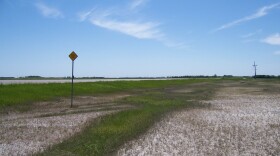“The chance to find a pasque-flower is a right as inalienable as free speech.”
That much quoted passage from Aldo Leopold’s A Sand County Almanac has been on my mind lately. Nothing symbolizes spring on the North Dakota prairie more than the flowering of the pasque flower or wild crocus. And if the pasque flowers are not already blooming near you, they will be soon.
In case you are not familiar with this little prairie gem, the pasque flower is a perennial member of the buttercup family that grows on upland prairie across the state. They are among the earliest of our wildflowers. The stems of the pasque flower grow to about 2-4 inches in height and are covered with dense silky hairs. At the top of each stem is one solitary cup-shaped flower, about 1-2 inches across and consisting of six lavender to white petal-like sepals, often with the insides a little lighter in color. They may be found growing individually or several in a cluster.
As we all know, spring weather can be quite fickle. And a big factor in the pasque flower’s ability to grow and blossom so early in the spring has to do with all those dense silky hairs, which create a warmer microclimate around the plant. Temperatures around the plant can be considerably warmer than the surrounding air. Plus, the cup-shaped flowers serve as little solar collectors and have also been reported to track the sun. Temperatures inside the flower may be up to 18 degrees warmer than the surrounding air. Small insects are a common sight within the flowers, and no doubt the warmth is part of the reason why.
The pasque flower has a long and important history of human interest and use. Several Native American tribes used the plant to treat a variety of ailments, including as a counterirritant and also to aid in childbirth. The pasque flower is also the State flower of South Dakota and the Provincial flower of Manitoba. And although not common in flower gardens, the pasque flower has been a species of interest.
Dr. Leon Snyder states in his Northern Plants for Northern Gardens that seeds of pasque flowers, planted as soon as they are ripe, should bloom the third year (patience is a virtue in gardening too!). Although I didn’t see anything about seedbed preparation, most seeds of prairie plants should be planted very shallow in a firm seedbed.




